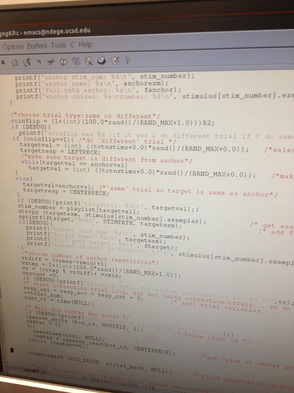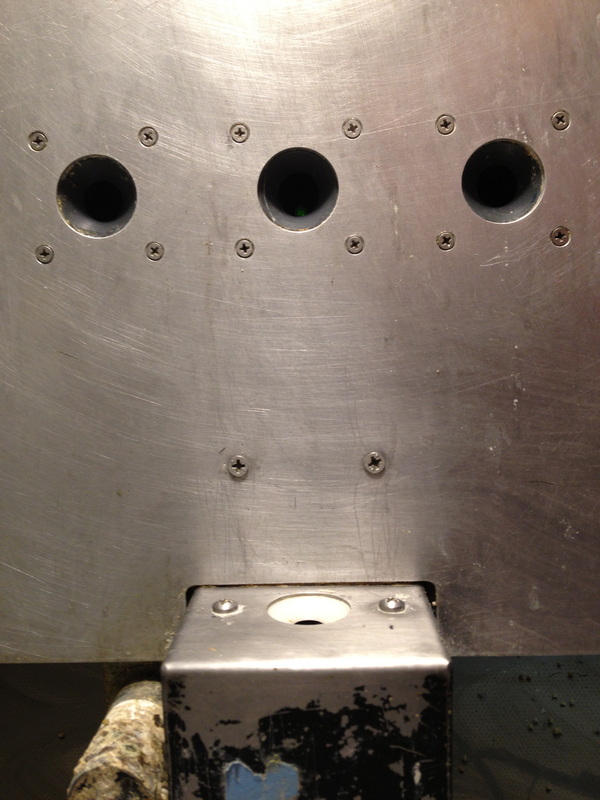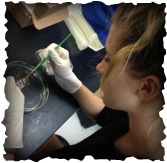
Here we are, at day five already... These past five days have completely blown my mind - as much as I've learned already, the over-arching lesson I've seen so far is that there are infinite questions to ask and answer!
Yesterday, Krista and I recorded activity in the morning from the bird we performed surgery on, on Tuesday. It was really exciting to see that procedure come full circle when we attached to lots of cells and were able to wake the bird up at the end of the session. We were able to seal to two cells, which we recorded from. Although we haven't determined anything for sure yet, we're pretty confident that they were auditory cells!
After recording, we went to a lab meeting in which one of Krista's peers presented his dissertation in order for the group to give him feedback. It was really interesting to watch one of the core pieces of my educational background be brought to my professional future, since High Tech High puts such a crucial emphasis on effective presentation and public speaking skills. Using those skills that I've learned in skill alongside the content that I've learned in the lab, I was able to break-down most of his dissertation and understand it's core meaning. Throughout his presentation, I took notes for myself to remember content ideals as well as what I hope to include in my presentations to the lab. After he was finished, we all headed down to Tim's office to give him feedback and critique. Although I'm not yet knowledgeable enough (my hope is that I soon will be!) to comment on the content as a full participant in the lab, I was able to give advice on the fluidity of his presentation and give him my perspective as a viewer who isn't as familiar with his research as his peers in the lab. It was especially important for me to experience and understand the norms of the lab meeting environment, because next Friday I'm presenting for the lab meeting! So far, I'm a combination of excited and nervous for the prospects of it's execution and outcome, but I figure if I can grapple with the content of the lab, understand the recording process, begin to understand text-based interfaces, and most importantly understand terminal procedures - I can give a presentation on what I know. I'm looking forward to it!
After returning from the presentation, I observed as Krista debugged a procedure in the shaping program. She was using an empty cage box and the stimuli we created in MatLab on Monday to test the procedure of her next project. The structure of these projects take some getting used to (I find myself now near-in-love with them), but I'll give it a shot - The terminal procedure of the project is called same-different (here's one of those intuitive terms I mentioned earlier). A same-different procedure begins a trial by listening to a stimuli. After the first stimuli is played, there is a couple seconds of silence before a second stimuli is played. The task of the same-different procedure requires the bird to identify whether the second stimuli is the same as the first.
Back to this specific project, Krista is identifying how 'helpful' it is for a bird to have an anchor stimuli when it is discriminating between same or different stimuli, especially when noise (and white noise) is playing in the background. - That's just about the most simple description I can give so far!
So yesterday, Krista finished "debugging" the program. Here's where I had to make a distinction - debugging is searching through the interface of the program to fix any errors, troubleshooting the program is testing it to see if the debugging process worked and the previous errors have been fixed. Once Krista fixed the final errors, we added spacing between our practice stimuli. Here's something else I just recently understood - The first play of the anchor stimuli is on a continuous stream, we have to manually add in the space between tones. After all the errors were debugged, the next step was to create some white noise in the text program interface of the procedure.
This is when I learned the difference between white noise and noise. Noise (not white noise) is anything that causes us to be distracted from what we actually want to hear. The example Krista gave was being in a crowded room and attempting to talk to one person - we have to filter out the noise that the public around us is making in order to make the distinction between the frequencies of the noises around us and frequency of the voice of the person we want to listen to, in order to hear and understand them. White noise is created through the computer system. There are no frequencies of sound, the values of white noise are random, scattered and purely numerical. The simplest way to make the distinction for me is that noise has a frequency, because there is a frequent wave of sound - but with white noise, nothing is frequent, nothing is related, it's just numbers. It's logical connections like this that I've learned to make at High Tech High, where I have to remember content that seems similar because it's related - you have to come up with tricks for your brain in order to remember and understand it all.
For today, Thursday (day five), Krista and I are working a little more on developing the presentation for next week and a little later we're heading to a class for her to teach a seminar. More to learn, more to learn! I'm so stoked on everything I've been working on so far and I can't wait for what's to come!
Yesterday, Krista and I recorded activity in the morning from the bird we performed surgery on, on Tuesday. It was really exciting to see that procedure come full circle when we attached to lots of cells and were able to wake the bird up at the end of the session. We were able to seal to two cells, which we recorded from. Although we haven't determined anything for sure yet, we're pretty confident that they were auditory cells!
After recording, we went to a lab meeting in which one of Krista's peers presented his dissertation in order for the group to give him feedback. It was really interesting to watch one of the core pieces of my educational background be brought to my professional future, since High Tech High puts such a crucial emphasis on effective presentation and public speaking skills. Using those skills that I've learned in skill alongside the content that I've learned in the lab, I was able to break-down most of his dissertation and understand it's core meaning. Throughout his presentation, I took notes for myself to remember content ideals as well as what I hope to include in my presentations to the lab. After he was finished, we all headed down to Tim's office to give him feedback and critique. Although I'm not yet knowledgeable enough (my hope is that I soon will be!) to comment on the content as a full participant in the lab, I was able to give advice on the fluidity of his presentation and give him my perspective as a viewer who isn't as familiar with his research as his peers in the lab. It was especially important for me to experience and understand the norms of the lab meeting environment, because next Friday I'm presenting for the lab meeting! So far, I'm a combination of excited and nervous for the prospects of it's execution and outcome, but I figure if I can grapple with the content of the lab, understand the recording process, begin to understand text-based interfaces, and most importantly understand terminal procedures - I can give a presentation on what I know. I'm looking forward to it!
After returning from the presentation, I observed as Krista debugged a procedure in the shaping program. She was using an empty cage box and the stimuli we created in MatLab on Monday to test the procedure of her next project. The structure of these projects take some getting used to (I find myself now near-in-love with them), but I'll give it a shot - The terminal procedure of the project is called same-different (here's one of those intuitive terms I mentioned earlier). A same-different procedure begins a trial by listening to a stimuli. After the first stimuli is played, there is a couple seconds of silence before a second stimuli is played. The task of the same-different procedure requires the bird to identify whether the second stimuli is the same as the first.
Back to this specific project, Krista is identifying how 'helpful' it is for a bird to have an anchor stimuli when it is discriminating between same or different stimuli, especially when noise (and white noise) is playing in the background. - That's just about the most simple description I can give so far!
So yesterday, Krista finished "debugging" the program. Here's where I had to make a distinction - debugging is searching through the interface of the program to fix any errors, troubleshooting the program is testing it to see if the debugging process worked and the previous errors have been fixed. Once Krista fixed the final errors, we added spacing between our practice stimuli. Here's something else I just recently understood - The first play of the anchor stimuli is on a continuous stream, we have to manually add in the space between tones. After all the errors were debugged, the next step was to create some white noise in the text program interface of the procedure.
This is when I learned the difference between white noise and noise. Noise (not white noise) is anything that causes us to be distracted from what we actually want to hear. The example Krista gave was being in a crowded room and attempting to talk to one person - we have to filter out the noise that the public around us is making in order to make the distinction between the frequencies of the noises around us and frequency of the voice of the person we want to listen to, in order to hear and understand them. White noise is created through the computer system. There are no frequencies of sound, the values of white noise are random, scattered and purely numerical. The simplest way to make the distinction for me is that noise has a frequency, because there is a frequent wave of sound - but with white noise, nothing is frequent, nothing is related, it's just numbers. It's logical connections like this that I've learned to make at High Tech High, where I have to remember content that seems similar because it's related - you have to come up with tricks for your brain in order to remember and understand it all.
For today, Thursday (day five), Krista and I are working a little more on developing the presentation for next week and a little later we're heading to a class for her to teach a seminar. More to learn, more to learn! I'm so stoked on everything I've been working on so far and I can't wait for what's to come!


 RSS Feed
RSS Feed